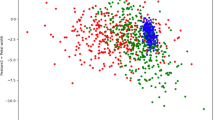Abstract
Different classifier functions can be defined in the framework of a quantum approach to machine learning. While the fidelity-classifier is based on a measure of similarity between quantum states, other classifiers refer to the possibility of an empirical discrimination between different states. An important example is represented by the Helstrom-classifier that has been successfully applied to some empirical simulations, for instance to the study of bio-medical images. An interesting case is represented by the evaluation of clonogenic assays: a technique whose aim is measuring the survival-degree of in vitro-cell cultures, based on the ability of a single cell to grow and to form a colony. In this field a quantum approach allows us to increase the classification-accuracy, in comparison with the corresponding results that are currently obtained in the case of most classical approaches. Some open problems and some possible further developments are mentioned in the conclusion of the article.




Similar content being viewed by others
Notes
References
Giuntini, R., Freytes, H., Park, D.K., Blank, C., Holik, F., Chow, K.L., Sergioli, G.: Quantum state discrimination for supervised classification. arXiv:2104.00971v1 [quant-ph] (2021)
Giuntini, R., Holik, F., Park, D.K., Freytes, H., Blank, C., Sergioli, G.: Quantum-inspired algorithm for direct multi-class classification. Appl. Soft Comput. 134, 109956, ISSN: 1568-4946, (2023)
Helstrom, C.W.: Quantum detection and estimation theory. J. Stat. Soc. Lond. 1, 231–252 (1969)
Militello, C., et al.: MF2C3: Multi-feature fuzzy clustering to enhance cell colony detection in automated clonogenic assay evaluation. Symmetry 12(5), 773 (2020). https://doi.org/10.3390/sym12050773
Sergioli, G., Bosyk, G.M., Santucci, E., Giuntini, R.: A Quantum-inspired version of the classification problem. Int. J. Theor. Phys. 56, 3880–3888 (2017)
Sergioli, G., Giuntini, R., Freytes, G.: A new quantum approach to binary classification. PLOS ONE 14(5), e0216224 (2019)
Sergioli, G., Militello, C., Rundo, L., Minafra, L., Torrisi, F., Russo, G., K.L. Chow, K.L., Giuntini, R.: A quantum-inspired classifier for clonogenic assay evaluations. Sci. Rep. 11–2830 (2021)
Acknowledgements
R. Giuntini and G. Sergioli are partially supported by the projects: i) “Ubiquitous Quantum Reality (UQR): understanding the natural processes under the light of quantum-like structures”, funded by Fondazione di Sardegna (code: F73C22001360007); ii) “CORTEX The COst of Reasoning: Theory and EXperiments”, funded by the Ministry of University and Research (Prin 2022, cod. 2022ZLLR3T): iii) “Quantum Models for Logic, Computation and Natural Processes (Qm4Np)” funded by the Ministry of University and Research (Prin-Pnrr 2022 cod. P2022A52CR). R. Giuntini is partially funded by the TÜV SÜD Foundation, the Federal Ministry of Education and Research (BMBF) and the Free State of Bavaria under the Excellence Strategy of the Federal Government and theLänder, as well as by the Technical University of Munich-Institute for Advanced Study.
Author information
Authors and Affiliations
Contributions
All authors contributed equally to the conceptualization of the work, the execution of the experiments, and the writing of the manuscript
Corresponding author
Ethics declarations
Competing interests
The authors declare no competing interests.
Additional information
Publisher's Note
Springer Nature remains neutral with regard to jurisdictional claims in published maps and institutional affiliations.
Rights and permissions
Springer Nature or its licensor (e.g. a society or other partner) holds exclusive rights to this article under a publishing agreement with the author(s) or other rightsholder(s); author self-archiving of the accepted manuscript version of this article is solely governed by the terms of such publishing agreement and applicable law.
About this article
Cite this article
Dalla Chiara, M.L., Giuntini, R. & Sergioli, G. A Quantum Approach to Pattern Recognition and Machine Learning. Part II. Int J Theor Phys 63, 44 (2024). https://doi.org/10.1007/s10773-024-05567-1
Received:
Accepted:
Published:
DOI: https://doi.org/10.1007/s10773-024-05567-1




